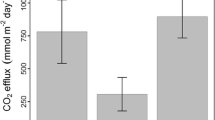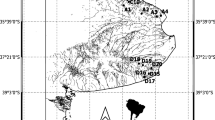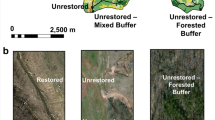Abstract
Ephemeral streams and wetlands are characterized by complex cycles of submersion and emersion, which influence the greenhouse gas flux rates. In this study we quantify the spatiotemporal variability in CO2 and CH4 concentrations and fluxes of an intermittent first-order stream over three consecutive wet and dry cycles spanning 56 days, to assess how hydrologic phase transitions influence greenhouse gas evasion. Water column excess CO2 ranged from −11 to 1600 μM, and excess CH4 from 1 to 15 μM. After accounting for temporal changes in the ratio of wet versus dry streambed hydraulic radius, total CO2–C fluxes ranged from 12 to 156 mmol m−2 day−1, with an integrated daily mean of 61 ± 25 mmol m−2 day−1. Soil–air evasion rates were approximately equal to those of water–air evasion. Rainfall increased background water–air CO2–C fluxes by up to 780% due to an increase in gas transfer velocity in the otherwise still waters. CH4–C fluxes increased 19-fold over the duration of the initial, longer wet-cycle from 0.1 to 1.9 mmol m−2 day−1. Temporal shifts in water depth and site-specific ephemerality were key drivers of carbon dynamics in the upper Jamison Creek watercourse. Based on these findings, we hypothesise that the cyclic periodicity of fluxes of biogenic gases from frequently intermittent streams (wet and dry cycles ranging from days to weeks) and seasonally ephemeral watercourses (dry for months at a time) are likely to differ, and therefore these differences should be considered when integrating transient systems into regional carbon budgets and models of global change.

Source ArcGIS 10.3. (ESRI; Redlands, CA)






Similar content being viewed by others

References
Alin SR, Rasera MF, Salimon CI, Richey EJ, Holtgrieve GW, Krusche AV, Snidvongs A (2011) Physical controls on carbon dioxide transfer velocity and flux in low-gradient river systems and implications for regional carbon budgets. J Geophys Res 116:G01009
Bakker DC, Bange HW, Gruber N (2014) Air–sea interactions of natural long-lived greenhouse gases (CO2, N2O, CH4) in a changing climate. In: Liss PS, Johnson MT (eds) Ocean–atmosphere interactions of gases and particles. Springer Earth System Sciences, New York
Bass AM, Munksgaard NC, Leblanc M, Tweed S, Bird MI (2014) Contrasting carbon export dynamics of human impacted and pristine tropical catchments in response to a short-lived discharge event. Hydrol Process 28:1835–1843
Battin TJ, Luyssaert S, Kaplan LA, Aufdenkampe AK, Richter A, Tranvik LJ (2009) The boundless carbon cycle. Nat Geosci 2:598–600
Beaulieu JJ, Shuster WD, Rebholz JA (2012) Controls on gas transfer velocities in a large river. J Geophys Res Biogeosci 117:G02007
Bernal S, Schiller D, Sabater F, Martí E (2012) Hydrological extremes modulate nutrient dynamics in Mediterranean climate streams across different spatial scales. Hydrobiologia 719:31–42
Bernot MJ, Sobota DJ, Hall RO et al (2010) Inter-regional comparison of land-use effects on stream metabolism. Freshw Biol 55:1874–1890
Birch HF (1958) The effect of soil drying on humus decomposition and nitrogen availability. Plant Soil 10:9–31
Biron PM, Roy AG, Courschesne F, Hendershot WH, Côté B, Fyles J (1999) The effects of antecedent moisture conditions on the relationship of hydrology to hydrochemistry in a small forested watershed. Hydrol Process 13:1541–1555
Bogard MJ, del Giorgio PA, Boutet L et al (2014) Oxic water column methanogenesis as a major component of aquatic CH4 fluxes. Nat Commun 5:5350
Borges AV, Darchambeau F, Teodoru CR et al (2015) Globally significant greenhouse-gas emissions from African inland waters. Nat Geosci 8:637–642
Buffam I, Galloway JN, Blum LK, McGlathery KJ (2001) A stormflow/baseflow comparison of dissolved organic matter concentrations and bioavailability in an Appalachian stream. Biogeochemistry 53:269–306
Bureau of Meteorology (BoM) (2015a) Climate data online. Australian Government Bureau of Meteorology. http://www.bom.gov.au/climate/averages/tables/cw_063039.shtml. Accessed 26 Oct 2015
Bureau of Meteorology (BoM) (2015b) Climate data online. Australian Government Bureau of Meteorology. http://www.bom.gov.au/watl/eto/. Accessed 26 Oct 2015
Butman D, Raymond PA (2011) Significant efflux of carbon dioxide from streams and rivers in the United States. Nat Geosci 4:839–842
Campeau A, Lapierre J, Vachon D, del Giorgio PA (2014) Regional contribution of CO2 and CH4 fluxes from the fluvial network in a lowland boreal landscape of Québec. Glob Biogeochem Cycle 28:1–13
Casas-Ruiz JP, Tittel J, von Schiller D (2016) Drought-induced discontinuities in the source and degradation of dissolved organic matter in a Mediterranean river. Biogeochemistry 127:125–139
Catalán N, von Schiller D, Marcé R, Koschorreck M, Gómez-Gener L, Obrador B (2014) Carbon dioxide efflux during the flooding phase of temporary ponds. Limnetica 33:349–360
Claret C, Boulton A (2009) Integrating hydraulic conductivity with biogeochemical gradients and microbial activity along river–groundwater exchange zones in a subtropical stream. Hydrogeol J 17:151–160
Costigan KH, Daniels MD, Dodds WK (2015) Fundamental spatial and temporal disconnections in the hydrology of an intermittent prairie headwater network. J Hydrol 522:305–316
Crusius J, Wanninkhof R (2003) Gas transfer velocities measured at low wind speed over a lake. Limnol Oceanogr 48:1010–1017
Datry T, Larned ST, Tockner K (2014) Intermittent rivers: a challenge for freshwater ecology. Bioscience 64:229–235
Davidson EA, Janssens IA (2006) Temperature sensitivity of soil carbon decomposition and feedbacks to climate change. Nature 440:165–173
Dieter D, von Schiller D, García-Roger EM et al (2011) Preconditioning effects of intermittent stream flow on leaf litter decomposition. Aquat Sci 73:599–609
Dinsmore KJ, Billett MF (2008) Continuous measurement and modeling of CO2 losses from a peatland stream during stormflow events. Water Resour Res 44:W12417
Dinsmore KJ, Wallin MB, Johnson MS, Billett MF, Bishop K, Pumpanen J, Ojala A (2013) Contrasting CO2 concentration discharge dynamics in headwater streams: a multi-catchment comparison. J Geophys Res Biogeosci 118:445–461
Dodds WK (2006) Eutrophication and trophic state in rivers and streams. Limnol Oceanogr 51:671–680
Dodds WK, Perkin JS, Gerken JE (2013) Human impact on freshwater ecosystem services: a global perspective. Environ Sci Technol 47:9061–9068
Fazi S, Vazquez E, Casamayor EO, Amalfitano S, Butturini A (2013) Stream hydrological fragmentation drives bacterioplankton community composition. PLoS ONE 8:e64109
Frankignoulle M (1988) Field measurements of air-sea CO2 exchange. Limnol Oceanogr 33:313–322
Frew NM, Goldman JC, Dennett MR, Johnson AS (1990) Impact of phytoplankton-generated surfactants on air-sea gas exchange. J Geophys Res 95:3337–3352
Frew NM, Bock EJ, Schimpf U et al (2004) Air–sea gas transfer: its dependence on wind stress, small-scale roughness, and surface films. J Geophys Res 109:C08S17
Fryirs KA, Cowley K, Hose GC (2016) Intrinsic and extrinsic controls on the geomorphic condition of upland swamps in Eastern NSW. Catena 137:100–112
Gallo EL, Lohse KA, Ferlin CM et al (2014) Physical and biological controls on trace gas fluxes in semi-arid urban ephemeral waterways. Biogeochemistry 121:189–207
Godsey SE, Kirchner JW (2014) Dynamic, discontinuous stream networks: hydrologically driven variations in active drainage density, flowing channels and stream order. Hydrol Process 28:5791–5803
Gómez-Gener L, Obrador B, Marcé R et al (2016) When water vanishes: magnitude and regulation of carbon dioxide emissions from dry temporary streams. Ecosystems 19:710–723
Hagen EM, McTammany ME, Webster JR, Benfield EF (2010) Shifts in allochthonous input and autochthonous production in streams along an agricultural land-use gradient. Hydrobiologia 655:61–77
Haines AT, Finlayson BL, McMahon TA (1988) A global classification of river regimes. Appl Geogr 8:255–272
Hall RO, Yackulic CB, Kennedy TA et al (2015) Turbidity, light, temperature, and hydropeaking control primary productivity in the Colorado River, Grand Canyon. Limnol Oceanogr 60:512–526
Hansen WF (2001) Identifying stream types and management implications. For Ecol Manag 143:39–46
Harrison JA, Matson PA, Fendorf SE (2005) Effects of a diel oxygen cycle on nitrogen transformations and greenhouse gas emissions in a eutrophied subtropical stream. Aquat Sci 67:308–315
Haverd V, Raupach MR, Briggs PR et al (2013) The Australian terrestrial carbon budget. Biogeosciences 10:851–869
Ho DT, Bliven LF, Wanninkhof R, Schlosser P (1997) The effect of rain on air–water gas exchange. Tellus B 49:149–158
Ho DT, Veron F, Harrison E, Bliven LF, Scott N, McGillis WR (2007) The combined effect of rain and wind on air–water gas exchange: a feasibility study. J Mar Syst 66:150–160
Holgerson MA, Raymond PA (2016) Large contribution to inland water CO2 and CH4 emissions from very small ponds. Nat Geosci 9:222–226
Holmes NT (1999) Recovery of headwater stream flora following the 1989–1992 groundwater drought. Hydrol Process 13:341–354
Hook AM, Yeakley JA (2005) Stormflow dynamics of dissolved organic carbon and total dissolved nitrogen in a small urban watershed. Biogeochemistry 75:409–431
Jähne B, Münnich K, Dutzi R, Huber W, Libner P (1987) On the parameters influencing air–water gas exchange. J Geophys Res 92:1937–1949
Janke BD, Finlay JC, Hobbie SE, Baker LA, Sterner RW, Nidzgorski D, Wilson BN (2014) Contrasting influences of stormflow and baseflow pathways on nitrogen and phosphorus export from an urban watershed. Biogeochemistry 121:209–228
Jeanneau L, Denis M, Pierson-Wickmann A, Gruau G, Lambert T, Petitjean P (2015) Sources of dissolved organic matter during storm and inter-storm conditions in a lowland headwater catchment: constraints from high-frequency molecular data. Biogeosciences 12:4333–4343
Johnson MS, Weiler M, Couto EG, Riha SJ, Lehmann J (2007) Storm pulses of dissolved CO2 in a forested headwater Amazonian stream explored using hydrograph separation. Water Resour Res 43:W11201
Johnson MS, Lehmann J, Riha SJ, Krusche AV, Richey JE, Ometto JP, Couto EG (2008) CO2 efflux from Amazonian headwater streams represents a significant fate for deep soil respiration. Geophys Res Lett 35:L17401
Jones JB, Mulholland PJ (1998) Carbon dioxide variation in a hardwood forest stream: an integrative measure of whole catchment soil respiration. Ecosystems 1:183–196
Knorr KH, Lischeid G, Blodau C (2009) Dynamics of redox processes in a minerotrophic fen exposed to a water table manipulation. Geoderma 153:379–392
Koprivnjak JF, Dillon PJ, Molot LA (2010) Importance of CO2 evasion from small boreal streams. Glob Biogeochem Cycle 24:GB4003
Kremer J, Nixon S, Buckley B, Roques P (2003) Technical note: conditions for using the floating chamber method to estimate air–water gas ex- change. Estuar Coast 26:985–990
Larned ST, Datry T, Arscott DB, Tockner K (2010) Emerging concepts in temporary-river ecology. Freshw Biol 55:717–738
Leopold LB, Maddock T (1953) The hydraulic geometry of stream channels and some physiographic implications. United States Geological Survey, Reston, pp 1–57
Looman A, Santos IR, Tait DR, Webb JR, Sullivan CA, Maher DT (2016) Carbon cycling and exports over diel and flood-recovery timescales in a subtropical rainforest headwater stream. Sci Total Environ 550:645–657
Lorke A, Bodmer P, Noss C et al (2015) Technical note: drifting versus anchored flux chambers for measuring greenhouse gas emissions from running waters. Biogeosciences 12:7013–7024
Marshall JS, Palmer WM (1948) The distribution of raindrops with size. J Meteorol 5:165–166
McClain ME, Boyer EW, Dent CL et al (2003) Biogeochemical hot spots and hot moments at the interface of terrestrial and aquatic ecosystems. Ecosystems 6:301–312
McKenna SP, McGillis WR (2004) The role of free-surface turbulence and surfactants in air–water gas transfer. Int J Heat Mass Transf 47:539–553
McMahon TA, Finlayson BL (2003) Droughts and anti-droughts: the low flow hydrology of Australian rivers. Freshw Biol 48:1147–1160
Millero FJ (2007) The marine inorganic carbon cycle. Chem Rev 107:308–341
Mohanty SK, Saiers JE, Ryan JN (2015) Colloid mobilization in a fractured soil during dry-wet cycles: role of drying duration and flow path permeability. Environ Sci Technol 49:9100–9106
Nadeau TL, Rains MC (2007) Hydrological connectivity between headwater streams and downstream waters: how science can inform policy. J Am Water Resour Assoc 43:118–133
Neubauer SC, Megonigal JP (2015) Moving beyond global warming potentials to quantify the climatic role of ecosystems. Ecosystems 18:1000–1013
Palta MM, Ehrenfeld JG, Groffman PM (2014) “Hotspots” and “hot moments” of denitrification in urban brownfield wetlands. Ecosystems 17:1121–1137
Peter H, Singer GA, Preiler C, Chifflard P, Steniczka G, Battin TJ (2014) Scales and drivers of temporal pCO2 dynamics in an Alpine stream. J Geophys Res Biogeosci 119:1078–1091
Poulter B, Frank D, Ciais P et al (2014) Contribution of semi-arid ecosystems to interannual variability of the global carbon cycle. Nature 509:600–603
Prairie YT, del Giorgio PA (2013) A new pathway of freshwater methane emissions and the putative importance of microbubbles. Inland Waters 3:311–320
Raymond PA, Saiers JE (2010) Event controlled DOC export from forested watersheds. Biogeochemistry 100:197–209
Raymond PA, Zappa CJ, Butman D et al (2012) Scaling the gas transfer velocity and hydraulic geometry in streams and small rivers. Limnol Oceanogr Fluids Environ 2:41–53
Raymond PA, Hartmann J, Lauerwald R et al (2013) Global carbon dioxide emissions from inland waters. Nature 503:355–359
Raymond PA, Saiers JE, Sobczac WV (2016) Hydrological and biogeochemical controls on watershed dissolved organic matter transport: pulse-shunt concept. Ecology 97(1):5–16
Regnier P, Friedlingstein P, Ciais P et al (2013) Anthropogenic perturbation of the carbon fluxes from land to ocean. Nat Geosci 6:597–607
Richey JE, Devol AH, Wofsy SC, Victoria R, Riberio MN (1988) Biogenic gases and the oxidation and reduction of carbon in Amazon River and floodplain waters. Limnol Oceanogr 33:551–561
Rudorff CM, Melack JM, MacIntyre S, Barbosa CC, Novo EM (2011) Seasonal and spatial variability of CO2 emission from a large floodplain lake in the lower Amazon. J Geophys Res 116:G04007
Ruiz-Halpern S, Maher DT, Santos IR, Eyre BD (2015) High CO2 evasion during floods in an Australian subtropical estuary downstream from a modified acidic floodplain wetland. Limnol Oceanogr 60:42–56
Sabater S, Timoner X, Borrego C, Acuña V (2016) Stream biofilm responses to flow intermittency: from cells to ecosystems. Front Environ Sci 4:14. doi:10.3389/fenvs.2016.00014
Sadat-Noori M, Maher DT, Santos IR (2015) Groundwater discharge as a source of dissolved carbon and greenhouse gases in a subtropical estuary. Estuar Coast 39:639–656
Salemi LF, Groppo JD, Trevisan R, de Moraes JM, de Paula LW, Martinelli LA (2012) Riparian vegetation and water yield: a synthesis. J Hydrol 454–455:195–202
Shaw JR, Cooper DJ (2008) Linkages among watersheds, stream reaches, and riparian vegetation in dryland ephemeral stream networks. J Hydrol 350:68–82
Sheldon F, Bunn SE, Hughes JM, Arthington AH, Balcombe SR, Fellows CS (2010) Ecological roles and threats to aquatic refugia in arid landscapes: dryland river waterholes. Mar Freshw Res 61:885–895
Sjögersten S, Black CR, Evers S, Hoyos-Santillan J, Wright EL, Turner BL (2014) Tropical wetlands: a missing link in the global carbon cycle? Glob Biogeochem Cycle 28:1371–1386
Snelder TH, Datry T, Lamouroux N, Larned ST, Sauquet E, Pella H, Catalogne C (2013) Regionalization of patterns of flow intermittence from gauging station records. Hydrol Earth Syst Sci 17:2685–2699
Sonnentag O, van der Kamp G, Barr AG, Chen JM (2010) On the relationship between water table depth and water vapor and carbon dioxide fluxes in a minerotrophic fen. Glob Change Biol 16:1762–1776
Stanford JA, Ward JV (2001) Revisiting the serial discontinuity concept. Regul River 17:4–5
Steward AL, von Schiller D, Tockner K et al (2012) When the river runs dry: human and ecological values of dry riverbeds. Front Ecol Environ 10:202–209
Strahler AN (1957) Quantitative analysis of watershed geomorphology. Civ Eng 101:1258–1262
Tamooh F, Borges AV, Meysman FJ, Van Den Meersche K, Dehairs F, Merckx R, Bouillon S (2013) Dynamics of dissolved inorganic carbon and aquatic metabolism in the Tana River Basin, Kenya. Biogeosciences 10:6911–6928
Teodoru CR, Nyoni FC, Borges VA, Darchambeau F, Nyambe I, Bouillon S (2015) Dynamics of greenhouse gases (CO2, CH4, N2O) along the Zambezi River and major tributaries, and their importance in the riverine carbon budget. Biogeosciences 12:2431–2453
Thauer RK, Kaster AK, Seedorf H, Buckel W, Hedderich R (2008) Methanogenic archaea: ecologically relevant differences in energy conservation. Nat Rev Microbiol 6:579–591
Threatened Species Scientific Committee (TSSC) (2005) Commonwealth listing advice on temperate highland peat swamps on sandstone. Australian Government Department of Environment. http://www.environment.gov.au/node/14561. Accessed on 2 Dec 2015
Timoner X, Acuña V, von Schiller D, Sabater S (2012) Functional responses of stream biofilms to flow cessation, desiccation and rewetting. Freshw Biol 57:1565–1578
Tweed S, Leblanc M, Bass AM, Harrington GA, Munksgaard NC, Bird MI (2016) Leaky savannas: the significance of lateral carbon fluxes in the seasonal tropics. Hydrol Process 30:873–887
Vachon D, Prairie YT (2013) The ecosystem size and shape dependence of gas transfer velocity versus wind speed relationships in lakes. Can J Fish Aquat Sci 70:1757–1764
von Schiller D, Marcé R, Obrador B, Gómez-Gener L, Casas-Ruiz JP, Acuña V, Koschorreck M (2014) Carbon dioxide emissions from dry watercourses. Inland Waters 4:377–382
von Schiller D, Graeber D, Ribot M, Timoner X, Acunã V, Martí E, Sabater S, Tockner K (2015) Hydrological transitions drive dissolved organic matter quantity and composition in a temporary Mediterranean stream. Biogeochemistry 123:429–446
Wanninkhof R (2014) Relationship between wind speed and gas exchange over the ocean revisited. Limnol Oceanogr Methods 12:351–362
Weiss RF (1974) Carbon dioxide in water and seawater: the solubility of a non-ideal gas. Mar Chem 2(3):203–215
Weyhenmeyer GA, Kortelainen P, Sobek S, Müller R, Rantakari M (2012) Carbon dioxide in boreal surface waters: a comparison of lakes and streams. Ecosystems 15:1295–1307
Weyhenmeyer GA, Kosten S, Wallin MB, Tranvik LJ, Jeppesen E, Roland F (2015) Significant fraction of CO2 emissions from boreal lakes derived from hydrologic inorganic carbon inputs. Nat Geosci 8:933–936
Xia J, Wu B, Wang G, Wang Y (2010) Estimation of bankfull discharge in the Lower Yellow River using different approaches. Geomorphology 117:66–77
Yamamoto S, Alcauskas JB, Crozier TE (1976) Solubility of methane in distilled water and seawater. J Chem Eng Data 21:78–80
Yvon-Durocher G, Allen AP, Bastviken D et al (2014) Methane fluxes show consistent temperature dependence across microbial to ecosystem scales. Nature 507:488–491
Acknowledgements
Special thanks are given to V. Kumar and C. Barton of Western Sydney University (UWS), the Blue Mountains City Council (BMCC), C. Holloway (SCU), and W. Davis for their assistance with logistics. We acknowledge funding from the Australian Research Council (LE120100156, DE140101733 and DE150100581).
Author information
Authors and Affiliations
Corresponding author
Ethics declarations
Conflict of interest
The authors declare that they have no conflict of interest.
Additional information
Responsible Editor: Jennifer Leah Tank.
An erratum to this article is available at http://dx.doi.org/10.1007/s10533-017-0347-4.
Electronic supplementary material
Below is the link to the electronic supplementary material.
Rights and permissions
About this article
Cite this article
Looman, A., Maher, D.T., Pendall, E. et al. The carbon dioxide evasion cycle of an intermittent first-order stream: contrasting water–air and soil–air exchange. Biogeochemistry 132, 87–102 (2017). https://doi.org/10.1007/s10533-016-0289-2
Received:
Accepted:
Published:
Issue Date:
DOI: https://doi.org/10.1007/s10533-016-0289-2



